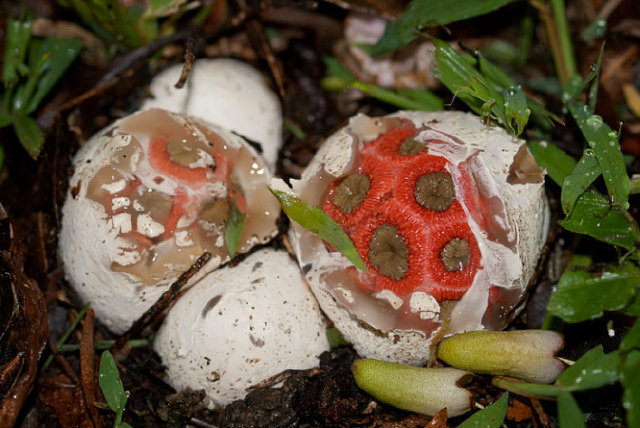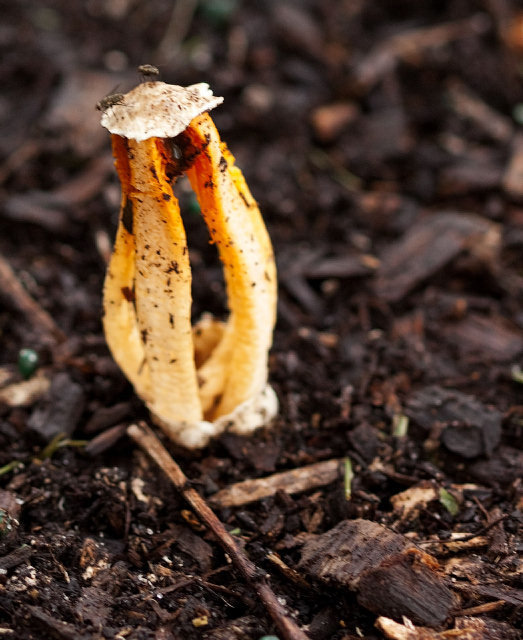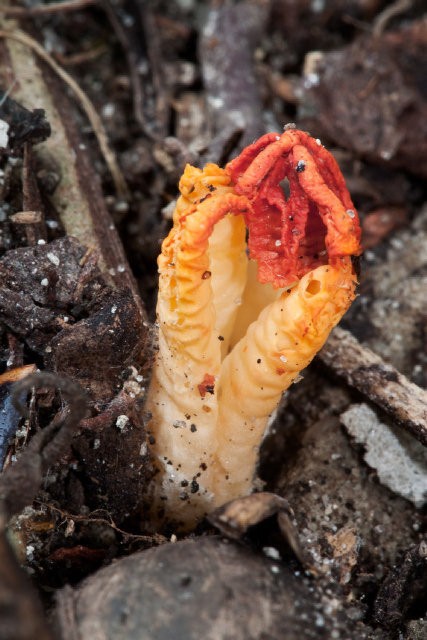A stinky family moves in

As published in The Miami Herald
They are nearly impossible to miss. They are neither plant nor animal, though they share traits of both. The bright-red globes have been popping up in gardens and mulched areas in South Florida and Gulf Coast areas for years. And they smell horrendous.
Believe it or not, they are mushrooms. These fungi are commonly called lattice stinkhorn mushrooms, but are not the kind of mushrooms you would want to eat.
 |
| The lattice stinkhorn mushroom (Clathrus crispus). |
A neighbor had initially pointed out to me that “something weird” was growing down my block. Naturally I grabbed my camera and ran. The individual was covered in flies, smelled like rotten meat and had a lattice pattern on its surface, hence its common name, the lattice stinkhorn.
Stinkhorns belong to the Phallaceae family of fungi, and quite often live up to their family name in shape. They usually live up to their common name in smell as well, and like you and I, they love the tropics.
The lattice example, shaped like an elongated ball, is known to science as Clathrus crispus. The Clathrus genus embodies an impudent group of very weird-looking fungi as it turns out; evidence of this — to me at least — includes mushrooms that look like rooster claws (Clathrus columnatus) or the devil’s fingers (Clathrus archeri). Our lattice friend even has a sibling: Clathrus ruber. They look very similar, but the holes making up the latticework in C. crispus are radially grooved. Don’t want to get close enough to look for the difference? That’s fine. You’re more likely to encounter C. crispus in our region anyhow, as it’s a tropical species, first described in Haiti.
 |
| Lattice stinkhorn “egg” stage. |
Many fungi exist for most of their lives secretly underground, unseen by us. It’s only when the mycelium — the vegetative part of the fungus — creates fruit that we see them. Mushrooms are actually the fruit of the fungus itself, as they’re used in reproduction and are responsible for broadcasting spores. Imagine an apple tree buried underground so only the apples towards the top are visible at the surface. That’s kind of like what’s going on with fungi, mushrooms being the apples.
And fungi belong to their own kingdom of life, being neither plant nor animal. Evolutionarily speaking, they are a bit more closely related to animals than to plants. Plus their cell walls are composed of chitin, a component of insect and crustacean exoskeletons. It doesn’t get much stranger than this.
 |
| The columned stinkhorn (Clathrus columnatus), or something closely related. |
The lattice stinkhorn appears first as an egg-like structure, covered in a white veil, which grows until it splits open in slimy, stinky glory. As it balloons out of the egg stage, the white veil disintegrates, freeing the red lattice structure to grow up into an oval, almost bulb shape. The sickly green areas open eventually to complete the hollowness of the fully formed fruit body, revealing the gleba — where all the spores reside. The slime covering it exudes the smell of carrion to attract flies, and does it ever! The flies get to eat, and the mushroom in turn has its spores carried aloft by the flies, on their bodies as well as in their excrement.
This friendly fungus is saprobic, i.e. feeding on already dead organic matter and not attacking anything still living like some other types of fungi may. That’s why it’s so often found on mulch in South Florida and the Gulf area — mulch is dead wood after all, where the stinkhorn’s spores may already be present. Great decomposers, fungi help break down mulch and dead wood in general, thus enriching your soil.
 |
| The stinky squid (Pseudocolus fusiformis), or something closely related. |
So if you see a fly- and slime-covered hollow red sphere growing from an egg in your yard, know that it’s not harming your trees or plants in any way, and is actually helping. If you really want to evict this stinky family of fungi, do not use a fungicide, which will do much more harm to our water reserves and soil than any good. You can simply use a shovel to scoop up the mushrooms and surrounding mulch or soil and throw them away.
